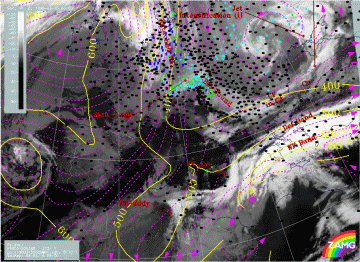06.00 UTC - Frontal Diagnosis - Relative streams and conveyor belts
|
15 March 1998/06.00 UTC - Meteosat IR image; position of vertical cross section indicated
|
15 March 1998/06.00 UTC - Vertical cross section; black: isentropes (ThetaE), orange thin: IR pixel values, orange thick: WV pixel values
|
Relative streams give an additional, different insight into the frontal processes as they reveal the different air masses involved and the associated sinking and rising. Two isentropic surfaces are selected which are representative of the two frontal zones (right image): 294K, a surface on top of the northern Cold Front zone and 308K, a surface within the southern Warm Front zone.
|
15 March 1998/06.00 UTC - Meteosat IR image; magenta: relative streams 294K - system velocity 273° 7 m/s, yellow: isobars, SatRep
overlay: names of conceptual models
|
|
The low isentropic surface of 294K is inclined downward from about 400 hPa to the surface in the area of the Cold Front. There is a relative stream from northern directions, very similar to a dry intrusion which crosses a large part of the Cold Front band under sinking motion; only in the area of the Black Sea and north of it is there rising again, which is in conformity with the conceptual model of Front Intensification by Jet Crossing (compare Conceptual Models: Front Intensification by Jewt Crossing ). That part of the cloud band which consists mainly of low cloud tops is in accordance with the sinking part of the dry intrusion.
|
15 March 1998/06.00 UTC - Meteosat IR image; weather events (green: rain and showers, blue: drizzle, cyan: snow, red: thunderstorm with
precipitation, purple: freezing rain, orange: hail, black: no actual precipitation or thunderstorm with precipitation), magenta:
relative streams 308K - system velocity 273° 7 m/s, yellow: isobars, SatRep overlay: names of conceptual models
|
|
A completely different situation is found on the higher isentropic surface. It is inclined from 400 hPa down to about 750 hPa. The main characteristic is a heavily rising relative stream from the south-east which is very similar to a Warm Conveyor Belt and splits into an eastern and western branch. This splitting is caused by the site of the low. There are already precipitation reports in the area of most intensive rising over the Aegean Sea. North of the warm front band the sinking dry stream can be recognized, which turns and runs parallel to the rising Warm Conveyor Belt in the area of the Deformation Band forming a limiting streamline there.
So there is a very distinct synoptic situation with a sinking dry stream from the north on lower isentropes and a strongly rising Warm Conveyor Belt on isentropic surfaces above.



